Russian neutron detector LEND for NASA Lunar Reconnaissance Orbiter space mission
-------------------------------------------------------------------------------------------------------------------------------------------------
-------------------------------------------------------------------------------------------------------------------------------------------------
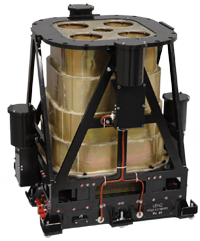
The Lunar Exploration Neutron Detector (LEND) scientific instrument is designed for NASA interplanetary mission Lunar Reconnaissance Orbiter 2009 (LRO). The program of the instrument includes launch of the LRO spacecraft in May 2009, cruise to the Moon and a year-long global mapping of the surface of our satellite (see NASA's press release № 04-407 from Dec. 22, 2004 NASA Selects Investigations for Lunar Reconnaissance Orbiter http://www.nasa.gov/).
The LEND project's main objective is to develop a highly sensitive scientific instrument that shall be used to search for water ice (presumably of a comet origin) in permanently shadowed lunar polar regions. LEND shall provide high-resolution hydrogen and hydrogen-bearing compounds (water ice in the first place) distribution map with spatial resolution 10 km in diameter (for polar regions) and sensitivity not less than 0.01% mass fraction. It shall also measure lunar neutron albedo as part of space radiation environment at altitudes of 30-60 km above lunar surface.
LEND uses registration of secondary neutrons coming from the Moon, which are born in the shallow layer of lunar subsurface within the depth of 1-2 m, that is constantly bombarded by space rays. High energy neutrons born in the subsurface are moderated and captured by main rockforming nuclei through the reactions of inelastic scattering and capture. The neutron flux emanating from the lunar soil depends on composition of the latter, and first of all, on presence of hydrogen or hydrogen-bearing compounds. Having collided with a hydrogen nucleus, a neutron immediately loses half of its energy, thus leading to quick thermalization and hence to significant increase of thermal neutron and decrease of epithermal neutron fluxes.
LEND incorporates nine detectors designed to measure thermal, epithermal, and fast neutron fluxes. Four collimated epithermal neutron detectors CSETN1 — CSETN4 have maximum sensitivity and minimal field of view (FOV). These detectors are based on large proportional counters filled with 3He and protected by cadmium shield from the side of the instrument's open FOV. Boron and polyethylene collimators absorb thermal and epithermal neutrons coming from outside FOV. Using the collimator allows to map epithermal neutron flux coming from the lunar surface with the resolution of 10 km from the orbit altitude of 50 km.
Three thermal neutron detectors STN1 — STN3 (Figure 1) and one epithermal neutron detector SETN are placed on the upper side of the collimator. These four detectors include similar proportional counters. The only difference of the SETN detector is a cadmium shell around the counter. STN1 and STN3 detectors are united in the so-called 'Doppler filter', which compares velocities of thermal neutrons with those of the orbiter. STN2 and SETN detectors measure the local field of thermal and epithermal neutrons in orbiter's vicinity. Neutrons are registered by gas-filled counters through nuclear reactions of neutron capture by 3He nucleus.
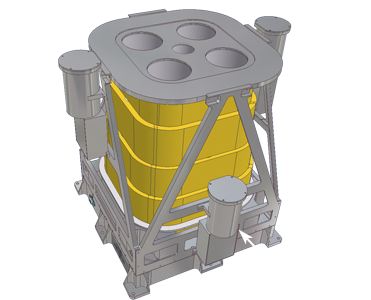
Figure 1. Outer detectors
SHEN detector is located in the inner space between collimators, and measures the neutron flux in the energy range of 300 keV to 15 MeV. It includes a scintillation detector based on a stilbene crystal, surrounded by a plastic scintillator to protect it from charged particles of cosmic rays (Figure 2). Fast neutron are registered in the organic crystal through recoil protons.
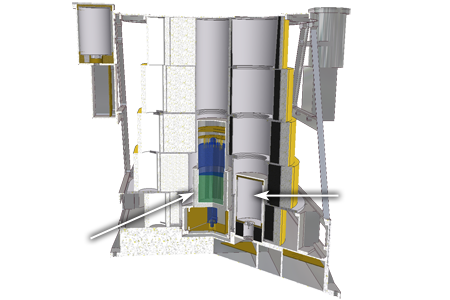
Figure 2. Internal detectors
During the cruise phase and on the near-lunar orbit LEND measures physical values as follows:
| Physical value | Parameters measured | Detectors |
| Thermal neutron flux | 16-channel counts spectrum in 3He counter, emerging from neutrons with energy less that 0.4 eV with temporal resolution from 1 s | STN1 — STN3 on the basis of 3He counters with the pressure of 20 atm and the volume of ~100 sm3 (produced by LND inc, USA) |
| Epithermal neutron flux | 16-channel counts’ spectrum in 3He counter, emerging from neutrons with the energy of 0.4 eV — ~0.3 MeV with the temporal resolution from 1 s | SETN, CSETN1 — CSETN4 on the basis of 3He counters with the pressure of 20 atm and the volume of ~100 sm3 (produced by LND inc, USA) |
| High energy neutron flux | 16-channel counts' spectrum in the scintillation detector, emerging from neutrons with the energy of 0.3 — >15 MeV with the temporal resolution from 1 s | SHEN scintillation detector on the basis of stilbene crystal with plastic anticoincidence shield. |
LEND is located on the LRO science deck and has simple mounting with eight pins. It is connected with the spacecraft by a special controlled thermal interface, sufficiently isolated from the open space by a multilayer thermal isolation. The spacecraft systems will maintain the operational temperature in the range of -20 °C – +50 °C. The electrical interface along with the data and commands interfaces were designed in accordance with project requirements.
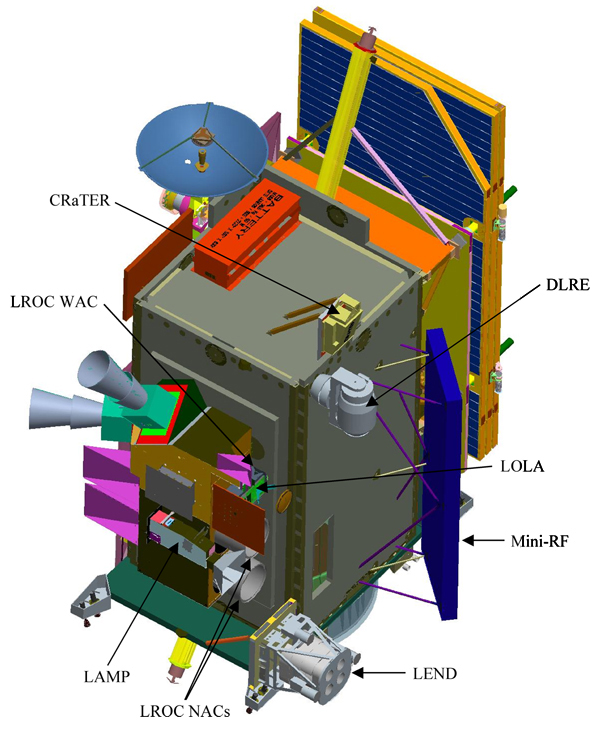
Figure 3. Scientific instruments aboard LRO ©
Figure 4 shows the LEND instrument without the multilayer thermal isolation.
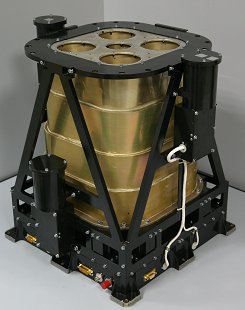
Figure 4 LEND without the multilayer thermal isolation
Figure 5 shows the LEND instrument covered by the multilayer thermal isolation.
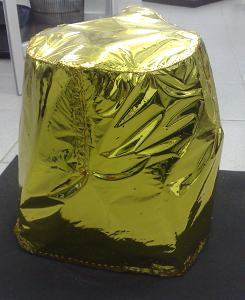
Figure 5. LEND covered with a multilayer thermal isolation
LEND Flight Units were delivered to NASA's Goddard Space Flight Center (Flight Unit-1 in March 2008, Flight Unit-2 in December 2008) and were successfully tested as the part of LRO spacecraft. On June 18, 2009 LEND was launched to the Moon. On June 20, 2009 LEND was switched on to the Scientific mode.
Even the very first LEND data obtained in the initial two months of the work aboard LRO allowed to study water distribution in polar regions of the Moon, deemed to be potentially important for future lunar exploration. Local regions with weak neutron emission were discovered at the lunar south pole, with very probable hydrogen-enhanced content in the regolith. Somewhat unexpectedly, these regions do not match the permanently shadowed regions (PSR) in the bottom of lunar polar craters, although it was assumed earlier that probable local regions with enhanced hydrogen content should coincide with PSRs in the poles' vicinity.
Using the LEND data as primary source of information along with the results of other LRO instruments, NASA chose Cabeus crater as a location for lunar surface bombardment in the LCROSS experiment. This experiment was aimed to study composition of lunar regolith to look for water ice by measuring the parameters of debris plume.
On September 15, 2009, after commissioning phase was officially completed, LEND began the main phase of the flight, that is to map neutron emission from the Moon with the spatial resolution of around 10 km.
The LEND results and plans for its further operation are discussed at regular workshops of Russian-American science group, which are held at IKI RAS and NASA's GSFC. Members of the LEND project also take part in mission planning and meeting of LRO science team.
As for now, LEND is functioning normally. Telemetry and science data are received at IKI RAS and processed by the LEND science team, as well as are sent to Planetary Data System https://starbrite.jpl.nasa.gov/pds4/about/, thus becoming available for science community. The results of the experiment were published in several journals (18 peer reviewed papers) and presented at scientific conferences (>110 presentations).
| Telemetry volume : | 250 Мb per day |
| Mass : | 26.3 kg |
| Power consumption : | 13 W |
| Dimensions : | 460 x 460 x 440 mm |
| Energy range : | from thermal energies up to 15 MeV |
| Time resolution : | variable, > 1 s |
| Spatial resolution on the surface : | 5 km from the 50 km orbit |
| Spatial resolution inside the subsurface : | 1-2 m |
Funding organization ― Federal Space Agency of the Russian Federation
Primary contractor ― Space Research Institute of the Russian Academy of Sciences (IKI RAS)
Principal Investigator ― Dr. Igor Mitrofanov
Works on the LEND project are carried out on the basis of the State contract №025-5452/04 from February 27, 2004 (R&D theme MSP-2001) and are included in the Federal Space Program for 2006–2016.
Works on the LEND project are planned for 2004–2008 (development, tests, assembling, and instrument delivery) and 2009– Until now (operating and data processing).
| Joint Stock Company "State Scientific Center Research Institute of Atomic Reactors" (Dimitrovgrad-10, Ulyanovsk distr.) |
Development of collimator based on boron carbide enriched with 10В isotope. |
| A.A. Blagonravov Institute for Engineering Science of the Russian Academy of Sciences (IMASH, Moscow) |
Development of mathematical model of instrument mechanical structure; participation in the development of testing facilities for LEND instrument in compliance with NASA requirements; development of mechanical test program; support of the instrument testing. |
| Joint Institute for Nuclear Research (JINR, Dubna, Moscow district) |
Numerical modeling of LEND counting parameters; participation in the development of LEND physical scheme; preparation for and calibrations of the instrument with natural and artificial neutron sources and testbed. |
| P.K. Sternberg Astronomy Institute of Moscow State University (SAI MSU, Moscow) |
Modeling of geological features on lunar surface for LEND construction optimization and data processing; Developing a database on types of soil and lunar regions for data processing. |
| A.F. Ioffe Physical Technical Institute (FTI, St.-Petersburg) |
Analysis of conditions of lunar neutron albedo formation and its spectrum dependence on temperature for data processing. |
| Joint-Stock-Company «Specialized scientific research institute for instrumentation engineering» (SNIIP, Moscow) |
Electronic scheme design development for neutron scintillation tract for fast neutron registration. |
| Goddard Space Flight Center (Greenbelt, USA) |
Instrument testing aboard the spacecraft, data processing together with other instruments' data. |
| University of Arizona (UofA, USA) |
Instrument operation during the flight, data preparation. |
| University of Maryland (UMD, USA) |
Studies of nuclear reactions in the shallow subsurface in the presence of hydrogen. |
| Catholic University of America (CU, USA) |
Data preparation, models of water ice in the lunar shallow subsurface. |



